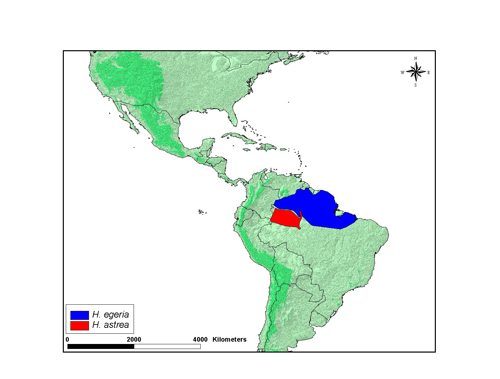Heliconius egeria
Margarita BeltránIntroduction
An Amazonian Heliconius species exhibiting the common red-and-yellow "dennis/ray" mimetic wing pattern.
Etymology: Egeria was a water nymph and a goddess. She took care of Hippolytus, son of Theseus (founder of Athens) after he was raised from the dead, until he changed his name and became Virbius. She was most famously the second wife and counselor of the second king of Rome, Numa Pompilius.
Characteristics
Early stages: Eggs are cream and approximately 1.2 x 0.9 mm (h x w). Females usually place 1 to 3 eggs on growing shoots of the host plant. Mature larvae have a orange body, with black head and scoli, length is around 2 cm. Caterpillars are gregarious. (Brown, 1981).
Geographical Distribution
Heliconius egeria is distributed in the Eastern Amazon. This map shows an approximate representation of the geographic distribution of this species. The original data used to draw these maps are derived from Brown (1979) which is available at Keith S. Brown Jr. (1979). Ecological Geography and Evolution in Neotropical Forests
Habits
H. egeria occurs from sea level to 1,300 m in the forest canopy. Usually individuals fly rapidly and in the canopy. Females mate multiply and adults roost solitarily at night 2-10 m above the ground on twigs or tendrils.
Host plant: H. egeria larvae feed primarily on plants from the genus Passiflora, subgenus Distephana (Brown, 1981).
References
Brown K. S. 1981 The Biology of Heliconius and Related Genera. Annual Review of Entomology 26, 427-456.
Cramer P. [1721_1776] 1975 De uitlandische Kapellen voorkomende in de drie Waereld-Deelen Asia, Africa en America. Papillons exotiques des trois parties du monde l'Asie, l'Afrique et l'Amérique. Amsteldam, S. J. Baalde; Utrecht, Barthelemy Wild and J. Van Schoonho-ven & Comp. 1(1/7): i-xxx, 1-16, 1-132, pls. 1-84.
About This Page

University of Cambridge, Cambridge, UK
Correspondence regarding this page should be directed to Margarita Beltrán at
Page copyright © 2010
 Page: Tree of Life
Heliconius egeria .
Authored by
Margarita Beltrán.
The TEXT of this page is licensed under the
Creative Commons Attribution-NonCommercial-ShareAlike License - Version 3.0. Note that images and other media
featured on this page are each governed by their own license, and they may or may not be available
for reuse. Click on an image or a media link to access the media data window, which provides the
relevant licensing information. For the general terms and conditions of ToL material reuse and
redistribution, please see the Tree of Life Copyright
Policies.
Page: Tree of Life
Heliconius egeria .
Authored by
Margarita Beltrán.
The TEXT of this page is licensed under the
Creative Commons Attribution-NonCommercial-ShareAlike License - Version 3.0. Note that images and other media
featured on this page are each governed by their own license, and they may or may not be available
for reuse. Click on an image or a media link to access the media data window, which provides the
relevant licensing information. For the general terms and conditions of ToL material reuse and
redistribution, please see the Tree of Life Copyright
Policies.
- First online 18 February 2007
- Content changed 12 August 2008
Citing this page:
Beltrán, Margarita. 2008. Heliconius egeria . Version 12 August 2008 (under construction). http://tolweb.org/Heliconius_egeria/72248/2008.08.12 in The Tree of Life Web Project, http://tolweb.org/








 Go to quick links
Go to quick search
Go to navigation for this section of the ToL site
Go to detailed links for the ToL site
Go to quick links
Go to quick search
Go to navigation for this section of the ToL site
Go to detailed links for the ToL site